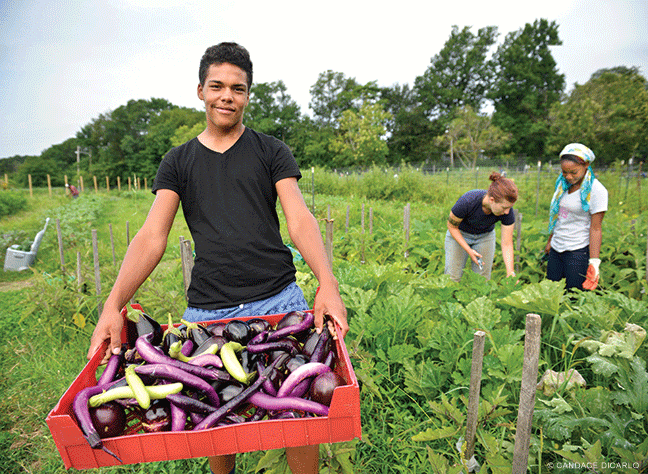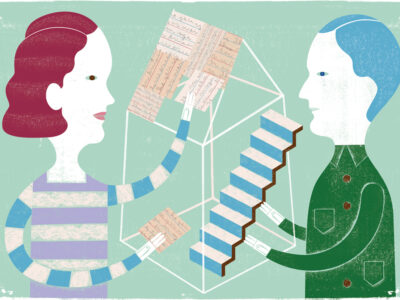
Mikel Young, a 10th grader at Bartram High School, shows off some of the harvest.
On the last Tuesday in July, two days before market day, 14-year-old Ryshawn Dobey mixed compost into a row of freshly tilled clover in Bartram’s Garden in Southwest Philadelphia. For a moment he leaned on his hoe and surveyed the zucchini vines, collards, eggplants, peppers, black-eyed peas, okra, tomatillos, rattlesnake pole beans, and Sungold tomatoes whose profuse growth blocked the view of still other crops beyond them.
“I’m going to say my favorite thing I’ve eaten here was the squash,” the stocky rising ninth-grader reflected. “Wait. No! It was the raspberries!”
He gazed up past a hill dotted with peach, pear, plum, cherry, apple, and nut saplings toward a bramble of raspberries that by this stage of the summer had been picked nearly clean. The view may have struck Dobey as particularly lovely, considering that he lives practically next-door in Bartram Village, a scruffy complex managed by the Philadelphia Housing Authority.
“My favorite thing to do,” Dobey continued, “is to harvest. Especially curly kale like this,” he said, swiveling his broad shoulders toward the row of plants growing behind him. “You make nice little bunches—and you always remember your bunch. When you’re up at the market, you always remember, ‘Yeah, I did that bunch. Buy this one!’”
For the moment, Dobey was on a field crew led by rising Penn junior Zoe Blickenderfer, an urban-studies major who spent the summer farming and mentoring local youth as part of a recent outgrowth of the Netter Center for Community Partnerships’ Agatston Urban Nutrition Initiative (AUNI).
In October 2011, AUNI partnered with the Pennsylvania Horticultural Society, the city of Philadelphia’s Parks & Recreation and Water departments, and Bartram’s Garden to create the Community Farm and Food Resource Center at Bartram’s Garden (CFFRC). The partnership transformed an underutilized ball field and a weed-conquered tennis court into a 3.5-acre farm site featuring a bit more than one acre under intensive cultivation, a community garden with around 55 individual plots, a solar-powered greenhouse for organic seedlings, and a nascent fruit orchard distinguished by historic heirloom varietals that harken back to the mid-18th century, when John Bartram cultivated North America’s premiere botanic collection here on the Schuylkill River’s right bank.
“Our main goals,” says project director Ty Holmberg, “are to provide access to healthy, local, nutritious food; to develop tools for self-reliance and food sovereignty so people can learn how to [provide] for themselves; and to provide a space in the city where people can reconnect to the land, their food, and each other.”
This summer, Holmberg and farm manager Christopher Bolden-Newsome oversaw eight Penn students and 22 local high-schoolers in an effort that dovetails with other aspects of AUNI’s nationally recognized university-assisted community schools model.
The AUNI grew out of an academically-based community-service (ABCS) anthropology course taught in the early 1990s by Francis Johnston Gr’62. Johnston (now an emeritus professor) and his undergraduate students started out by teaching nutrition and health to 46 sixth-graders at a nearby middle school, with the aim of reducing childhood obesity. The endeavor gradually expanded to offer school-day, after-school, and summer learning opportunities for more than 10,000 students and their families at 20 public schools and community centers in Philadelphia, with an emphasis on hands-on opportunities to grow, cook, eat, and sell healthy foods.
The CFFRC has adopted an entrepreneurial approach to supporting that core mission and extending it. In the last year, the greenhouse produced some 80,000 transplants destined for community and school gardens throughout Philadelphia. The young students on the farm also market their produce at a weekly stand in Southwest Philadelphia, as well as at University City’s larger Clark Park farmers market and through a small community-supported agriculture (CSA) subscription program. Cooking lessons and community feasts also figure into the summer routine for the youth participants, who are paid $7.25 an hour through a Philadelphia Youth Network grant administered by AUNI. For many of them, this is their first job.
The high-schoolers develop skills like public speaking and essay writing, and travel to a nearby public elementary school to teach younger summer-campers the basics of gardening, healthy eating, and food justice. (One of the program’s most-discussed field trips involved a comparison of the produce selection and pricing at two Fresh Grocer supermarkets: one on the edge of Penn’s campus at 40th and Walnut streets that offers a respectable array of fruit and vegetables, and one a mile-and-a-half away in the poorer Kingsessing neighborhood where, as Holmberg notes, “there are no organic options, there’s no variety—there’s like one type of apple—the quality is poor … even though it’s the same exact company.”)
As a project that makes use of public land and does not currently have a dedicated source of secure funding, the CFFRC is—like many of the Netter Center’s initiatives in their infancy—a somewhat experimental enterprise. The program is subject to a five-year memorandum of understanding between the Netter Center, the Pennsylvania Horticultural Society, and the John Bartram Association governing shared responsibilities and the use of the site, whose long-term success will depend on continued support by the partners who helped to transform this slice of the Schuylkill River bank.
(To learn more about John Bartram’s original use of the site—which some people have speculated was the location of Ben Franklin’s famous kite-flying experiments, according to Bartram’s Garden curator Joel Fry C’79 G’84—visit bartramsgarden.org.)
In April the CFFRC was honored with a Pennsylvania Governor’s Award for Environmental Excellence that cited the program’s “entrepreneurial jobs training and leadership development program for local high school students” in this low-income section of Philadelphia.
“The farm and garden at Bartram’s captures all the key ideas and components of the Agatston Urban Nutrition Initiative,” says Ira Harkavy C’70 Gr’79, the founding director of the Netter Center. “I think there are four academic courses that work with it, so it has that core academic health and nutrition partnership. It works with the community, with youth and adults, and with schoolchildren, which is crucial, because it has the active youth-development component of the Agatston Urban Nutrition Initiative.”
The driving ethos is that the program’s participants learn by being deliverers, not recipients, of valued services. For Penn students, that can mean anything from doing research toward a senior thesis to volunteering on a more ad hoc basis.
“The Netter Center’s work with the university-assisted schools, AUNI, Bartram’s Garden, all of them contain an approach in which students—in their academic courses, as volunteers, as work-study interns—can have an experience in which they engage in important civic work that makes a difference,” says Harkavy. “It helps them develop as citizens.”
The same goes for younger participants, he adds.
“They’re seeing the products of their labor, and they’re getting paid for it. That matters. And it’s for positive work: it’s socially valued, it’s personally valued, it’s transferable to their families, it gives them a sense of their own accomplishments. It’s different than hamburger-flipping—it’s learning work. They’re learning new things and they’re in touch with new people,” Harkavy says.
“A lot of these kids, you can see that they have the potential to go one way or another,” said Nina Kaledin, a junior classics major who opted to work for CFFRC instead of teaching sailing this summer, during a mid-morning break from the field. She reflected that the farm had recently hosted a visiting group of 13- and 14-year-olds whose number included two young teenagers wearing probation anklets.
“They could end up in trouble and on the streets and hustling,” she said. “And programs like AUNI solidify their chances to go to college, and to change their situation. I feel that’s such an important thing to do, especially in communities like Philadelphia, where the school systems aren’t exactly excelsior right now.”
A federal grant underwrites assessment of the program’s success with regard to its health and nutritional goals. According to a 2009 case study authored by Francis Johnston, analyses carried out by Penn students as part of their ABCS course work have concluded that middle- and high-school students involved in AUNI programs eat significantly more servings of fruits and vegetables than their peers.
Recently, Holmberg has been working with partners at Children’s Hospital of Philadelphia to evaluate “not just if this programming is affecting health, but if it’s affecting the way that [the youth participants] see themselves in the community, their empowerment, their leadership skills, and things like that.”
Given that the farm is only two-and-a-half years old, that will take time to determine. In the meantime, Ryshawn Dobey and his fellow farmhands have anecdotal evidence to light their way. In September, Dobey’s older brother Rasheed, a two-year veteran of the Community Farm and Food Resource Center at Bartram’s Garden, will matriculate at Voorhees College in South Carolina on a full scholarship.—T.P.




